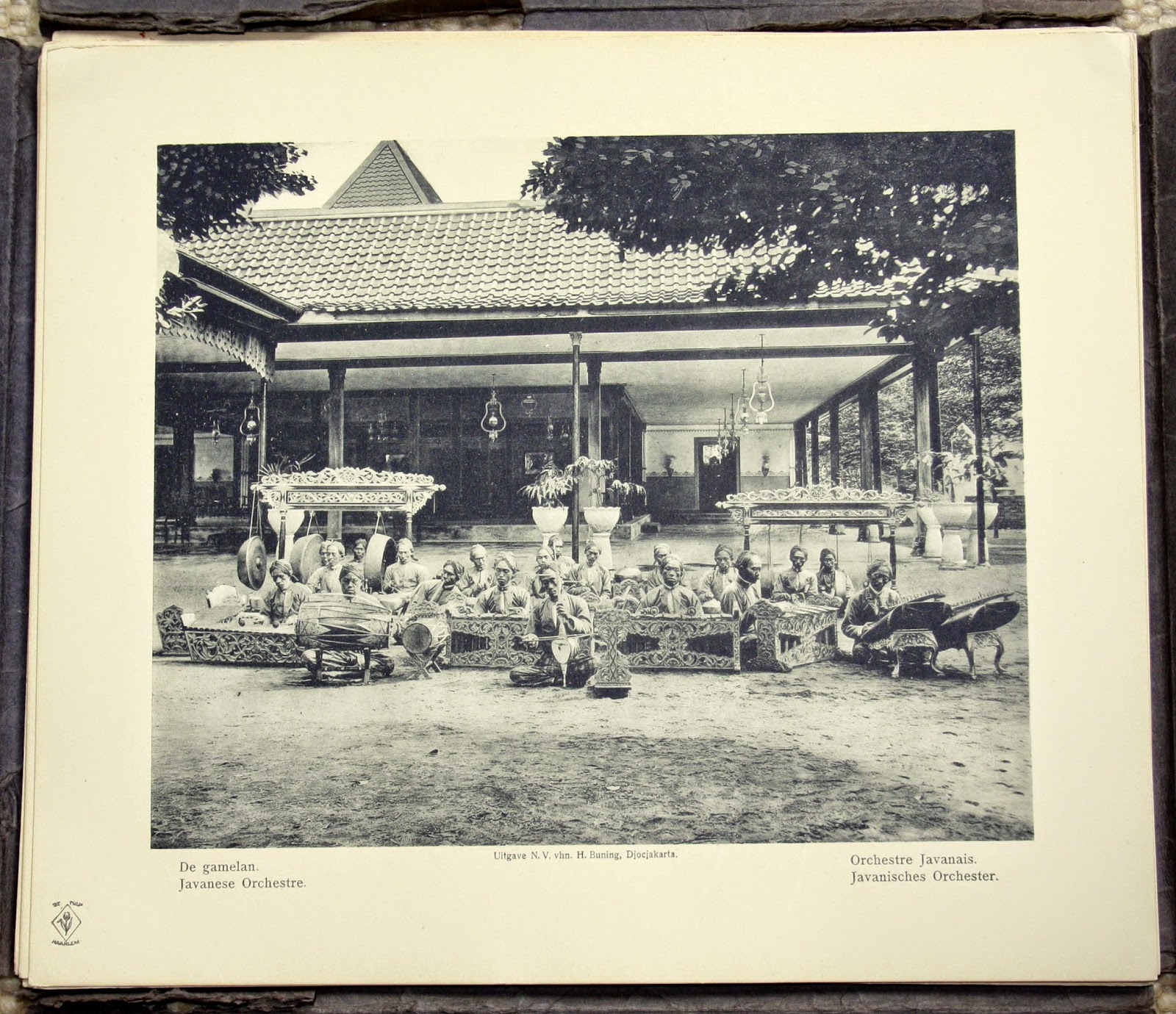Souvenir Album Midden-Java
Djocjakarta, N.V. v/h H. Buning [c. 1925] - Dark green paper portfolio with cover printed in gold containing 13 (of 20?) photo plates depicting Javanese dancers , opiumsmokers, brassworkers, batiking women, Javanese antiquities, the court of the Sultan of Djocja, a gamelan orchestra, etc., all with printed legends in Dutch, English, French and German measuring 23,5 x 28 cm. each. Slight wear to portfolio, plates in excellent condition.
See also
Nederlands-Indië in foto's, 1860-1940
Photography in the Dutch East Indies
The commercial photographers who started working in the Dutch East Indies from 1845 led a nomadic existence. They would set up a studio in a large town or hotel or at the home of an acquaintance, advertise in the local paper and take a photograph of anybody who had money to spare for that purpose. After a couple of weeks or months when the market had become saturated, they moved on to the next town. Among these pioneers were the two young Englishmen Walter Bentley Woodbury and James Page. From 1857 to 1908 Woodbury & Page was a leading firm in the photography sector in the Dutch East Indies.
Primarily, the commercial photographers took portraits of people, more particularly of prominent individuals. In addition, they sold topographic photos, i.e. pictures of important buildings, streets, volcanoes or agricultural enterprises. Pictures of the various population types in the colony also formed part of their repertoire. The topographic photos were chiefly sold as ‘souvenirs’.
During the last decades of the nineteenth century, the photographers’ wanderings came to an end. At that time, every large town had one or more permanently established photographers. The Surabayan photographers Onnes Kurkdjian and Herman Salzwedel and the Javan, Kassian Céphas (who worked in Yogyakarta) were famous names at the time.
The heyday of commercial photography was over by the beginning of the twentieth century and the role it played in forming an image of the Dutch East Indies diminished noticeably. There were two reasons for this. The introduction of the picture postcard brought an end to the market for topographic photos. And then, thanks to the many technical improvements, photography had essentially become the domain of amateurs: now everybody could make his or her own ‘souvenirs’.
The commercial photographers who started working in the Dutch East Indies from 1845 led a nomadic existence. They would set up a studio in a large town or hotel or at the home of an acquaintance, advertise in the local paper and take a photograph of anybody who had money to spare for that purpose. After a couple of weeks or months when the market had become saturated, they moved on to the next town. Among these pioneers were the two young Englishmen Walter Bentley Woodbury and James Page. From 1857 to 1908 Woodbury & Page was a leading firm in the photography sector in the Dutch East Indies.
Primarily, the commercial photographers took portraits of people, more particularly of prominent individuals. In addition, they sold topographic photos, i.e. pictures of important buildings, streets, volcanoes or agricultural enterprises. Pictures of the various population types in the colony also formed part of their repertoire. The topographic photos were chiefly sold as ‘souvenirs’.
During the last decades of the nineteenth century, the photographers’ wanderings came to an end. At that time, every large town had one or more permanently established photographers. The Surabayan photographers Onnes Kurkdjian and Herman Salzwedel and the Javan, Kassian Céphas (who worked in Yogyakarta) were famous names at the time.
The heyday of commercial photography was over by the beginning of the twentieth century and the role it played in forming an image of the Dutch East Indies diminished noticeably. There were two reasons for this. The introduction of the picture postcard brought an end to the market for topographic photos. And then, thanks to the many technical improvements, photography had essentially become the domain of amateurs: now everybody could make his or her own ‘souvenirs’.
See also
the Souvenir Photo Albums of the Dutch East Indies by Kurkdjian & Co Photo Studio Photography
Javanese Orchestre
Thronehall of the Sultan of Djocjacarta
The Tjandi Mendoet
The Tjandi-Prambanan
The Boro-Boedoer Temple
Small gate on the cemetery of the Sultan at Pasargede
Statue of Boeddha in the Tjandi Mendoet
Tandak-Dancer
Tandak-Girl
Card-Players
Opiumsmokers
Copperengraving
Batikmaking





























1 opmerking:
Hartelijk dank voor het met ons delen van deze prachtige foto's.
Een reactie posten